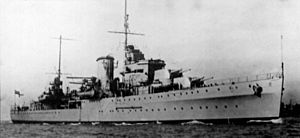Battle of Cape Passero (1940) facts for kids
Quick facts for kids Battle of Cape Passero (1940) |
|||||||
|---|---|---|---|---|---|---|---|
| Part of the Battle of the Mediterranean of World War II | |||||||
 British light cruiser HMS Ajax during World War II |
|||||||
|
|||||||
| Belligerents | |||||||
| Commanders and leaders | |||||||
| Strength | |||||||
| 1 heavy cruiser 1 light cruiser |
4 destroyers 3 torpedo boats |
||||||
| Casualties and losses | |||||||
| 13 killed 22 wounded 1 light cruiser damaged |
325 killed 1 destroyer sunk 2 torpedo boats sunk 1 destroyer damaged |
||||||
The Battle of Cape Passero was a naval battle during World War II. It happened on October 12, 1940. This fight was between the British Royal Navy and the Italian Navy (called the Regia Marina). It took place southeast of Sicily, near a place called Cape Passero.
The main British ship was the light cruiser HMS Ajax. The Italian side had seven ships: four destroyers and three torpedo boats. This battle happened right after the British had delivered supplies to Malta.
Contents
Why the Battle Happened
In October 1940, the British Mediterranean Fleet sent supplies to Malta. This mission was called MB6. The convoy had four cargo ships. They were protected by two anti-aircraft cruisers and four destroyers.
The main British fleet was led by Vice-Admiral Andrew Cunningham. His flagship was HMS Warspite. This fleet also included three other battleships, two aircraft carriers, six cruisers, and 16 destroyers. The supply ships reached Malta safely on October 11. Bad weather had stopped the Italian fleet from attacking earlier.
After the British ships left Malta, an aircraft spotted them. Meanwhile, HMS Ajax was sent away from the other cruisers. Her job was to scout ahead and look for enemy ships.
The Fight Begins
The Italian commander, Admiral Inigo Campioni, sent destroyers to Cape Bon. He thought the British ships might be heading towards Gibraltar. Admiral Campioni believed it was too late for his larger battleships and cruisers to attack the supply convoy.
At the same time, a group of four Italian destroyers and three torpedo boats was on patrol. They were spread out about 3 miles apart. The moon was full, making it easy to see. The Italian destroyers were the Artigliere , Camicia Nera, Aviere, and Geniere. The torpedo boats were the Ariel, Alcione, and Airone.
Torpedo Boat Attack
At 1:37 AM, the Italian torpedo boat Alcione spotted Ajax. The British cruiser was sailing east, about 19,600 yards away. By 1:48 AM, the three Italian torpedo boats were speeding towards Ajax. The British cruiser did not know the enemy was coming.
At 1:57 AM, Alcione fired two torpedoes from 1,900 yards away. Captain Banfi, who led the Italian torpedo boats, ordered his flagship Airone to fire its 100 mm guns. The other torpedo boats also opened fire. Three shots hit Ajax. Two hit the bridge, and one hit 6 feet below the waterline.
Ajax quickly realized it was under attack. It started firing at the closest torpedo boat, Ariel, while moving at full speed. Ariel was hit hard and sank about 20 minutes later. Its captain, Mario Ruta, and most of his crew were killed.
Airone was the next Italian ship to be hit. It managed to launch two torpedoes before it was badly damaged. Airone caught fire almost immediately. Ajax fired its machine guns at Airone's bridge and upper deck from close range. Airone sank a few hours later. Captain Banfi was among the survivors. The only undamaged Italian warship, Alcione, then left the battle at 2:03 AM.
Destroyer Attack
After the fight, Ajax continued sailing east. At 2:15 AM, its radar detected two Italian destroyers. Their commander, Captain Carlo Margottini, had seen the firing from the south. A radio problem had stopped Margottini from attacking with all his ships. Three of his destroyers had gone north-west instead of north as ordered.
Aviere was hit by a sudden blast from the British cruiser. This stopped its torpedo attack, and it had to retreat south, heavily damaged. Artigliere managed to fire one torpedo and four 120 mm gun salvos from 2,800 yards away before being hit and crippled. The torpedo missed Ajax. However, four shots hit two of Ajax's smaller gun turrets. They also destroyed a boat and disabled its radar.
After firing at Camicia Nera without success, Ajax stopped fighting. It had fired 490 rounds and four torpedoes. Thirteen of its crew were killed, and 22 were wounded. The cruiser needed a month of repairs before it could return to duty.
The damaged Artigliere had lost its commander and most officers. Camicia Nera tried to tow it away. But at dawn, the British cruiser HMS York surprised them. York chased off Camicia Nera and then sank the drifting Artigliere with a torpedo. The Italian Navy rescued the survivors the next day.
What Happened Next
This battle was the first time the Italian Navy saw how good the Royal Navy was at fighting at night. The British used special shells (starshells), searchlights, and burning ammunition. The Italians realized they needed to improve their own equipment and skills.
They also thought the British might be using radar, but they weren't sure yet. The Italians concluded that their air patrols had been poor. This stopped their larger ships from reacting quickly. It gave the British a tactical advantage, allowing them to avoid fighting when conditions were bad for them.




